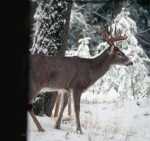At 30,568, whitetail deer harvest shatters Idaho's all-time record

Idaho Fish and Game officials predicted a banner hunting season for 2015, and hunters delivered with the highest all-time whitetail harvest and increased deer and elk harvests compared to the year prior.
Hunters took an estimated 30,568 whitetails in 2015, topping the 1996 record of 29,800.
The combined estimated mule deer and whitetail harvest was 68,764, which exceeded the 2014 harvest of 61,200 and was the highest deer harvest since 1991. The mule deer harvest was also 5,200 more than the previous year.
Clearwater regional wildlife biologist Dave Koehler was a little surprised to see a record whitetail harvest considering hunting conditions weren't ideal due to warm, dry weather in the fall. But he added that trends were pointing in that direction.
"Both harvest and hunter participation for whitetails has been on an upward trend since 1973," Koehler said.
An outbreak of bluetongue last summer hit some localized whitetail herds but had little effect on the overall population. It didn't appear there was an overharvest from the record take of whitetails, he added.
"None of the data we have suggests that's the case," Koehler said.
The overall success rate for deer hunters in 2015, including general seasons and controlled hunts, was 45 percent.
Elk hunters also had a good season by harvesting 24,543 of the game animals, which exceeded the 2014 harvest of 20,700. Combined hunter success for general elk seasons and controlled hunts was 27 percent.
The 2015 elk harvest was the highest since 1996 and the fifth-consecutive increased harvest, fish and game officials said.
Big-game harvests have been trending upward thanks, in part, to several consecutive mild winters and growing hunter numbers, including non-residents.
The harvest was bolstered by increases in doe and cow tags, which accounted for 28 percent of the deer harvest and 44 percent of the elk harvest. Further breakdowns of the 2015 harvest showed that hunters took 83 percent of the deer and 61 percent of the elk during general seasons, fish and game officials said.
While controlled hunts accounted for a smaller percentage of the harvest in the state, hunters who drew them had excellent success rates, officials added. About 60 percent of deer hunters and 45 percent of elk hunters who drew controlled-hunt tags took an animal.
Not surprising, the number of hunters was also up in 2015. Sales of deer and elk tags increased 6 percent in 2015. In addition, the 14,000 limit on non-resident deer tags sold out for the first time since 2008, which triggered the release of another 1,500 whitetail tags to accommodate late-season hunters.
Hunting statistics also showed a good mix of age classes for deer and elk.
The bull elk harvest was about 25 percent spikes, 38 percent between two and five points on at least one antler and 36 percent on six points or larger. The buck harvest was about 54 percent spikes to three points on at least one antler, 32 percent four points and 14 percent on five points or more.
Archery and muzzleloader hunters accounted for 23 percent of the elk harvest and 7 percent of the deer harvest.
Winter big-game monitoring is showing signs that bode well for the 2016 big game seasons, fish and game officials added.
Based on preliminary data from radio collared deer, 86 percent of fawns had survived through February. Monitoring is showing slightly lower fawn and doe survival than in the last two years, but those years had the highest over-winter survival since 1998 when fish and game started intensive monitoring herds.
Biologists will continue to closely monitor survival through spring. Officials added that March is among the worst months for deer mortality.
Elk are less susceptible to winter kill than deer. Through February, 99 percent of radio collared cow elk had survived along with 90 percent of collared calves.
